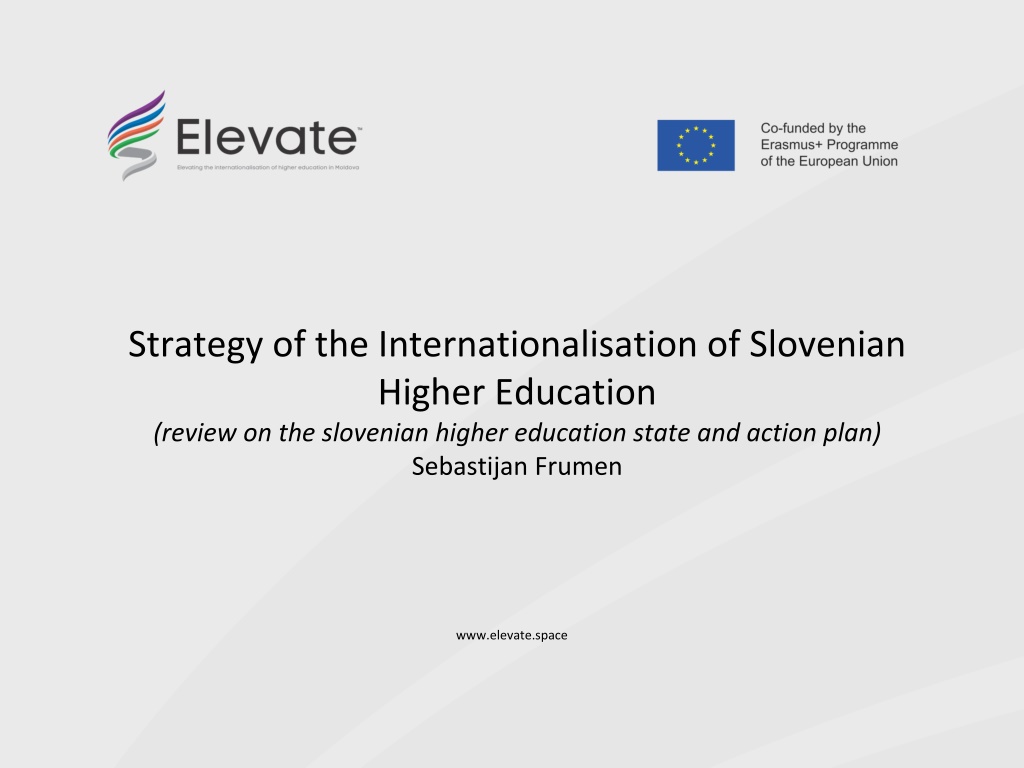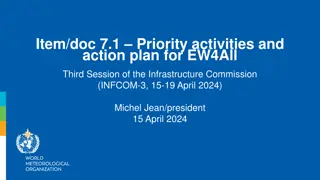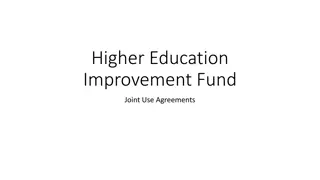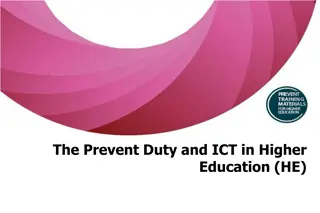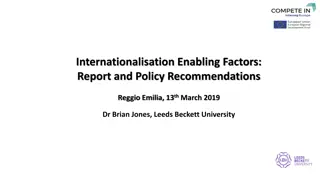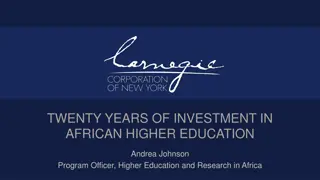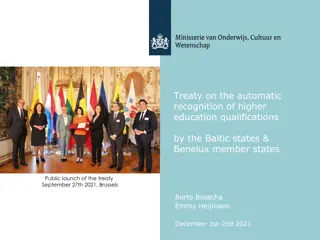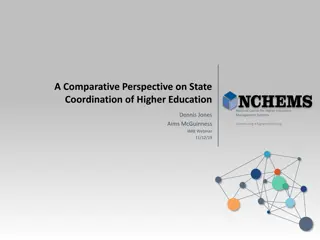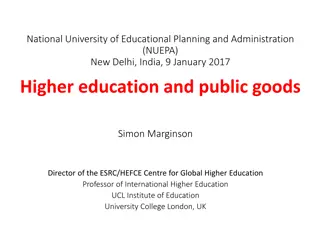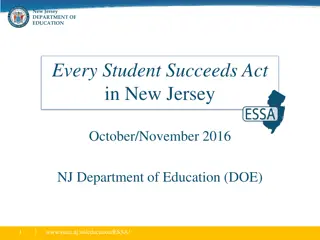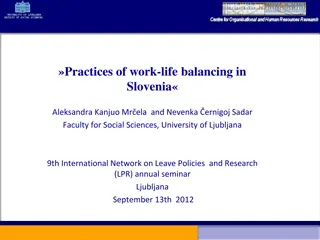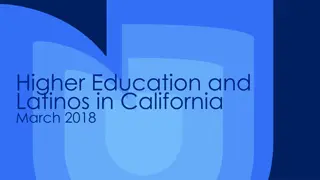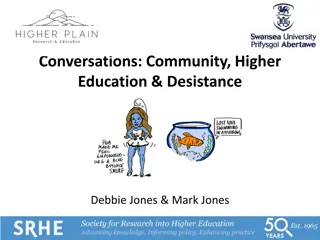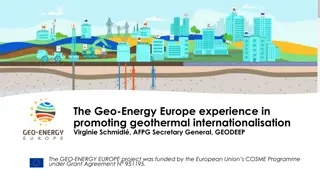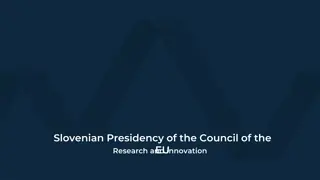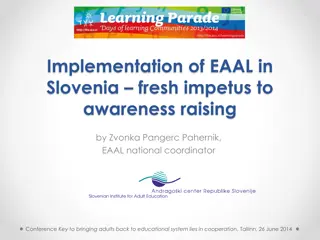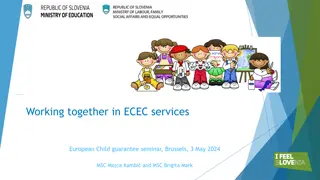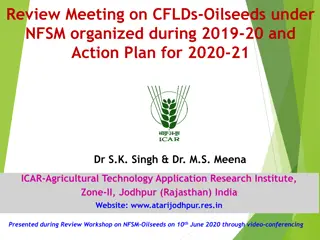Internationalisation of Slovenian Higher Education: State and Action Plan Review
The internationalisation of Slovenian higher education is vital for establishing global relationships. The state aims for sustainable partnerships, preservation of language, integrated policy, and national identity. Initiatives include resolution on national higher education program, strategy for internationalisation, and focus areas like mobility, research cooperation, intercultural competences, and targeted regions. Action plan 2016-2018 with various objectives is underway.
Download Presentation

Please find below an Image/Link to download the presentation.
The content on the website is provided AS IS for your information and personal use only. It may not be sold, licensed, or shared on other websites without obtaining consent from the author. Download presentation by click this link. If you encounter any issues during the download, it is possible that the publisher has removed the file from their server.
E N D
Presentation Transcript
Strategy of the Internationalisation of Slovenian Higher Education (review on the slovenian higher education state and action plan) Sebastijan Frumen www.elevate.space
The Internationalisation of Slovenian Higher Education 1. The internationalisation of higher education is important for the establishment and development of Slovenian s global relationships and connections in the world The internationalisation of the Slovenian higher education area shall proceed as a part of a long-term and sustainable process based on high-quality, holistic and balanced international partnerships. For that, the following is necessary: 2. A partnership between the government, higher education institutions and the wider public A partnership between key areas A common concern for the Preservation and development of the Slovenian language An integrated governmental policy The establishment of a recognizable, integrated, national identity for Slovenian higher education
Some Issues on Internationalisation in Slovenian Higher Education 1. Resolution on National Higher Education Programme 2011-2020: internationalisation as one of the key areas of further development for the sector 2. Strategy for internationalisation of Slovenian higher Education (SHE) 2016-2020: Adopted in July 2016 by the Government of the Republic of Slovenia SHE shall become a part of the global HE area by 2020 Despite positive trends in recent years, Slovenia still lags behind the OECD and EU averages in the international comparisons of mobility The strategic plan of the Ministry of Education, Science and Sport focuses primarily on the opening of the higher education and scientific research area The strategy is focused on five key areas: international mobility, openness of institutions towards the international environment, high quality international scientific research and development cooperation, promotion of intercultural competences and a focus on targeted priority regions and countries, as weel as the ongoing promotion, support and monitoring of the strategy Daring action plan for the period 2016-2018, within which we are pursuing 25 objectives and over 50 measures with a total value of 57 million, is already being implemented
Areas and Objectives 1. Mobility as a key component of the Slovenian higher education community, open to the international environment: 2. Quality international scientific research and development cooperation:
Areas and Objectives 3. Promoting the development of intercultural competences: 4. Targeting priority regions and countries: 5. Promotion, support and monitoring of the strategy:
Student mobility As is apparent from the Overview of Slovenian Higher Education in the Field of Internationalization, data shows that the mobility of Slovenian and international students and academic staff in Slovenia is among the lowest in the EU. 1. Mobility Slovenian students going out mobility (share according to Slovenian students population) 2. Mobility Foreign students coming in mobility (share according to Slovenian students population)
Student mobility 3. Mobility Slovenian students going out full study abroad (share according to Slovenian students population) In 2013 there was 2.370 Slovenians, enroled into study programmes all over the world. Most of the students, are studying in Austria (28 %), Italy (11,2 %), Germany (11, 2 %), USA and Netherlands. 4. Mobility Foreign students coming in full study abroad (share according to Slovenian students population) Last data shows (on 17. 11. 2017) how the numbers are increasing (full time students: 2016/17 5,5 % 2017/18 7,5 %
Student mobility Comparison share of outgoing and incoming students compared to other countries Measures, undertaken at national level: 1. OUTGOING MOBILITY: implementation of programmes Erasmus+ CEEPUS, bilaterals, additional funding for Erasmus (inclusion of students from disadvantaged backgrounds) national scholarships creating a system for monitoring the quality of mobilty, creating a database employers, offering student internship promoting the impacts of international mobility on the competences of international development of Slovenia is placed among last according to number of outgoing and incoming students.
Student mobility 2. INCOMING MOBILITY: Promoting Erasmus+ programmes, CEPUS, bilateral programmes Increasing support for mobility and for the process of internationalisation at home (info points, orientation days, Slovene language courses, preparation module for foreign students) Regulation of the relevant legislation Regular renewals of study agreements (West Balkan countries) Changes and amandments to the regulations on tuition fees and accommodation in students dormitories Offering courses on Slovenian language and culture to international students
Academic mobility 1. Mobility Slovenian staff going out (share according to Slovenian academic and professional staff) 2. Mobility Foreign staff coming in (share according to Slovenian academic and professional staff) Collaboration on amendments and additions to legislation Pilot project funding of projects, hosted at Slovenian HEIs Short- and long-term hosting of international experts and HE teachers at slovenian HEIs Offering courses on slovenian language and culture for foreign HE teachers Measures undertaken to increase the number of academic and staff mobility at national level: Promotion of Erasmus+ programmes (staff mobility) Mobility of Slovenian teachers higher education
International study programmes 1.Slovenian higher education institutions report that accreditation procedures of international joint study programmes in Slovenia are too complicated and last too long. 2. In 2016 the higher education registry contained 31 international joint study programmes: 3. According to data of the Slovenian ministry of higher education, there are 175 study programmes carried out in English (academic year 2016/17): 23 BA 77 MA 75 PhD 4. Data collected among Slovenian universities show that in 2013 three Slovenian universities carried out 536 courses in a foreign language (366 at UL, 86 at UM and 84 at UP).
International research and events International scientific research cooperation and the effective transfer of knowledge are fundamental to the successful sharing of research outcomes between higher education institutions and the labour market. As such, a Strategy for the Internationalisation of Slovenian Science is being drafted for the sector, stemming from the Slovenia s Research and Innovation Strategy 2011-2020. Its purpose is to shape and strengthen a successful and internationalised public research sector with a clear mission and vision to create excellent, internationally recognised, competitive research that has a significant impact on economic growth and employment. Measures, undertaken at national level for better international research and development cooperation: Removing administrative and technical barriers to ensure international mobility in bothe directions Enabling an effective network of information on career options for researchers in Slovenia and abroad Improving quality and quantity of international co-operation 1. 2. 3. Strengthening the functionality of the national network of national contact point for Horizon 2020 The Strategy for Internationalisation in the Field of Science and Research Participation in the enabling technologies and future emerging technologies development of key
